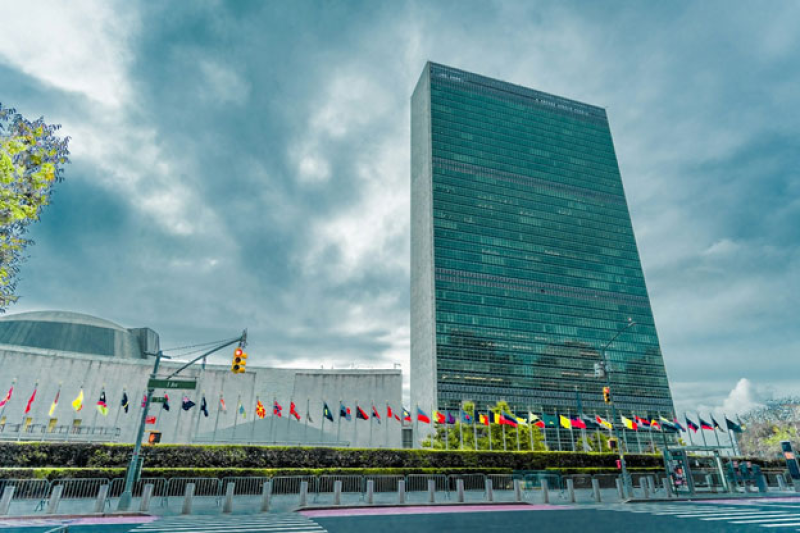- CA Yunus pays homage to Liberation War martyrs on Victory Day |
- Bangladesh capital market extends losing streak for second day |
- Bangladesh celebrates Victory Day Tuesday |
- 'Different govts presented history based on their own ideologies': JU VC |
FDI Shortfall Weakens Aid, Slows Global Relief Efforts

The United Nations Headquarters in New York
The world is losing interest in investing in others, especially when it comes to humanitarian aid. Foreign Direct Investment (FDI) has slowed to critical levels, weakening emerging markets and further slowing growth across developing nations.
As of 2025, FDI has dwindled to its lowest levels yet, largely due to heightened trade tensions and barriers to international investment. Lower levels of FDI indicate a shift toward domestic and isolationist efforts, increasing the likelihood of failed budgetary cooperation with international intergovernmental bodies such as the United Nations.
This is already evident in the UN’s budgets for the Secretariat and for humanitarian aid operations. With many of the UN’s largest donors cutting back on their contributions, the organisation will now see a 20 percent reduction in its workforce (6,900 jobs), in addition to scaling down humanitarian aid operations globally. On 20 June, Spokesperson for the Secretary-General Stéphane Dujarric remarked, “No office in the UN will be exempt from the 20 percent reduction, and that includes the Secretary-General’s office.” This suggests that the cuts are due to a reduced budget, not a desire for managerial optimisation of the UN’s staff. Under U.S. President Donald Trump, nearly USD 1.5 billion in missed payments contributed to a USD 3.7 billion budget cut to the UN. This financial strain has been further exacerbated by multiple overdue payments from China. Together, China and the U.S. make up just over 40 percent of the UN’s total budget.
These cuts have also impacted the UN Office for the Coordination of Humanitarian Affairs (OCHA), where “the deepest funding cuts ever to hit the international humanitarian sector” have occurred. This has resulted in OCHA presenting a new global “hyper-prioritised” appeal, aimed at supporting 114 million people facing life-threatening necessities worldwide. The new plan asks for USD 29 billion in funding, down from the USD 44 billion called for in the previous plan.
“We have been forced into a triage of human survival,” said Tom Fletcher, Under-Secretary-General for Humanitarian Affairs and Emergency Relief Coordinator. “The math is cruel, and the consequences are heartbreaking. Too many people will not get the support they need, but we will save as many lives as we can with the resources we are given.”
The Global Humanitarian Overview for 2025 originally called for USD 44 billion and aimed to reach about 180 million people out of the nearly 300 million in need. However, as of June, only USD 5.6 billion has been received — less than 13 per cent of the appeal. As a result, aid will be disbursed not purely by human necessity but by calculated prioritisation.
The new plan was designed with three goals. Firstly, to reach people facing the most urgent conditions, using a scale ranking humanitarian need and prioritising cases that reached level 4 (Extreme) and level 5 (Catastrophic). Secondly, to prioritise life-saving support as outlined in the 2025 Humanitarian Response. Thirdly, to ensure that limited resources are directed where they can have the greatest impact, accounting for the speed of disbursement capabilities.
In his statement, Fletcher concluded: “Brutal funding cuts leave us with brutal choices. All we ask is 1 percent of what you chose to spend last year on war. But this isn’t just an appeal for money – it’s a call for global responsibility, for human solidarity, for a commitment to end the suffering.”
The shortfall in humanitarian aid funding has coincided directly with global FDI pullbacks, reflecting a drop in donor confidence, a decreased interest in bilateral engagement, and an overall lack of security about investing in fragile states. For the 2023 financial year, developing economies received USD 435 billion in FDI (down from USD 867 billion in 2022), the lowest since 2005. A slowdown has also been observed in advanced/high-income economies, which received USD 336 billion in 2023 — the lowest since 1996. FDI as a portion of gross domestic product (GDP) accounted for 2.3 percent in developing economies in 2023, half of what it was at its 2008 peak.
To address the FDI shortfall, the World Bank has identified a three-policy priority plan for developing economies. The first is to “redouble efforts to attract FDI” by easing restrictions and speeding up investment processes. According to the World Bank, a 1 percent increase in a country’s labour productivity is associated with a 0.7 percent increase in FDI inflows.
The second is to “amplify the economic benefits of FDI,” which involves enhancing post-investment development outcomes and uplifting sectors that create opportunities for underrepresented groups. The third is to “advance global cooperation” by launching initiatives to increase international financial flows, provide geopolitical relief, and create institutional support for developing economies.
Boosting FDI would also encourage UN member states to expand or maintain their humanitarian contributions. FDI can be seen as a signal of global connectedness — stronger investment flows reinforce shared commitments to delivering aid. For an efficient system, full participation is essential, including capital mobilisation and clear communication. An increase in FDI provides a crucial backbone for countries facing crises. While the UN can support and implement many aid plans, true impact depends on individual states' willingness to invest in developing nations. Without this investment, these economies will remain stagnant and fall further behind on the global stage.
Meanwhile, official development assistance (ODA) is also on a global downward trend.

